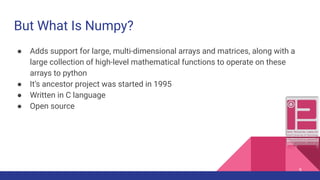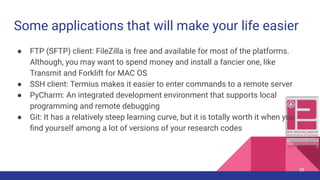PyTorch crash course
- 1. Getting Started with PyTorch For Implementing Deep Learning Supervised by Professor Shohreh Kasaei <[email protected]> Written by Nader Karimi Bavandpour <[email protected]> Image Processing Lab, Sharif University of Technology
- 2. Outline ● Prerequisite ● PyTorch Crash Course ● Useful Links About PyTorch ● How to Use a Remote Linux Server 2
- 3. Prerequisite ● Virtual envs, conda, pypi, etc ● Installing PyTorch: ○ Go to pytorch.org and let them redefine the simplicity for you 3
- 4. Prerequisite (cont.) ● We have prepared some Jupyter notebooks for you to play with in the rest. If you install Anaconda, you will already have Jupyter notebook available on your system. ● To use it with a specific virtual-env, first activate that env, and then enter this command: python -m ipykernel install --user --name=my-kernel-name. Then activate the defined kernel your jupyter notebook. (my new kernel name is tiramisu_ipk). See here for more information. ● Type jupyter notebook launch Jupyter 4
- 6. Prerequisite (cont.) ● If you are not interested in using Jupyter notebook, you can turn the notebook into a .py file easily. 6
- 9. But What Is Numpy? ● Adds support for large, multi-dimensional arrays and matrices, along with a large collection of high-level mathematical functions to operate on these arrays to python ● It’s ancestor project was started in 1995 ● Written in C language ● Open source 9
- 10. But What Is Numpy? ● How numpy.org website defines it: ● Take a look here to see how comprehensive it is ● Try to skim this tutorial so that you can come back to it later 10
- 11. Numpy and torch.Tensor Are Similar ● Let’s play with ‘numpy_tensor.ipynb’ notebook together 11
- 12. The Tensor Class ● Indexing, creating, in place, item(), cpu and gpu, autograd…. Squeeze, numpy bridge, variable class ● Please see here for more information 12
- 13. Autograd: Automatic Differentiation ● Some highlights from pytorch.org: 13
- 14. Autograd: Automatic Differentiation (cont.) ● Some important methods and statements we need to be familiar with: ○ Tensor.requires_grad: Returns a Boolean that shows if we are tracking gradient for a specific Tensor ○ Tesor.requires_grad_(Boolean): Changes requires_grad in place. ○ Tensor.backward(): Computes gradients and accumulates them in Tensor.grad variable ○ with torch.no_grad(): To prevent tracking history and evaluating a model ● Let’s play with the notebook ‘autograd_tutorial.ipynb’ together 14
- 15. Neural Networks: Intro ● We use the package ‘torch.nn’ to construct a neural network 15
- 16. Neural Networks: torch.nn ● Class torch.nn.Parameter: ○ A subclass of the Tensor class ○ It is special: When assigned as Module attributes they are automatically added to the list of its parameters, and will appear e.g. in parameters() iterator ● Why do you think it’s better to have a separate Parameter class? ● Let’s check PyTorch’s convolution source code: 16
- 17. Neural Networks: torch.nn (cont.) ● Torch.nn is base class for all neural network modules ● Your models should also subclass this class ● Useful methods and classes that you should be familiar with: ○ add_module(name, module) ○ apply(fn) ○ cpu() ○ cuda(device=None) ○ eval(): Sets the module in evaluation mode. Some modules, like dropout and batch-norm change behaviour in eval mode. ○ modules(): Returns an iterator over all modules in the network ○ parameters(recurse=True): Returns an iterator over module parameters ○ ModuleList class 17
- 18. Neural Networks: torch.nn (cont.) ● Let’s play with the notebook ‘neural_networks_tutorial’ together ● You can check Neural Transfer example at pytorch.org, which is, well, wonderful ● Check more neural network examples here 18
- 19. TensorboardX ● A professional logging technology ● It’s github page which is here which contains installation instructions ● It’s documentation page is here ● Usage example in ‘cifar10_tutorial.ipynb’ notebook 19
- 20. Useful Links About PyTorch ● Pytorch.org is a very good source of learning ○ List of tutorials is here ○ ‘DEEP LEARNING WITH PYTORCH: A 60 MINUTE BLITZ’ is the base of our PyTorch crash course! ● PyTorch’s forum is here ● Here is a wonderful set of slides that teach deep learning theory and implementation using PyTorch 20
- 21. How to Use a Remote Linux Server 21
- 22. Typical Operations You Will Probably Need ● Copying your source code to the server ● Copying your files, e.g., datasets to the server ● Copying result files from server back to your machine ● Install needed libraries, start running your code ● Check if some piece of server’s hardware is available ● ... 22
- 23. Some Useful Linux Commands 23 Command Task Options ([.] means optional) cd Change Directory pwd Print Working Directory ls List contents of a directory [path], [-{a,l,h,...}] touch Create a file [parent_directory/] filename nano Simple text editor filename cat See content of a file filename head See some of lines from top filename tail See some of last lines filename
- 24. Some Useful Linux Commands (cont.) ● Watch -n1 {command-name}. Example: watch -n1 gpustat, shows result of a command with periodic refresh ● Screen {[-x screen-name], [list]}: Use this so that your program keeps running while you are far far away ○ Examples: ■ Screen: create a new screen and go to it ■ Screen list: list all of available screens (attached or detached) ■ Screen -x screen-name: attach to an available screen ● gpustat: install by pip install gpustat ○ Watch -n1 gpustat is a useful combination 24
- 25. Some Useful Linux Commands (cont.) ● Create a new conda virtualenv ○ conda create -n yourenvname python=x.x anaconda ■ Example: conda create -n myenv python=3.6 anaconda ● Activate a conda virtualenv ○ Source activate yourenvname ● Deactivate a conda virtualenv ○ Source deactivate ● Install packages on a specific virtualenv: ○ First activate that env, then proceed like normal 25
- 26. Some Useful Linux Commands (cont.) ● To run your code: ● ‘tee’ command clones standard output 26
- 27. Some Useful Linux Commands (cont.) ● To run tensorboardX: ○ Tensorboard --logdir {log-directory} ● Set which GPU you want to use: ○ export CUDA_VISIBLE_DEVICES=0 (or =1) ● Use scp (secure copy) to copy files between server and your machine 27
- 28. Some applications that will make your life easier ● FTP (SFTP) client: FileZilla is free and available for most of the platforms. Although, you may want to spend money and install a fancier one, like Transmit and Forklift for MAC OS ● SSH client: Termius makes it easier to enter commands to a remote server ● PyCharm: An integrated development environment that supports local programming and remote debugging ● Git: It has a relatively steep learning curve, but it is totally worth it when you find yourself among a lot of versions of your research codes 28
- 29. How to Configure PyCharm ● Fill this fields. Then right-click on your server’s name and click set as default 29
- 30. How to Configure PyCharm (cont.) ● Fill this fields. Then right-click on your server’s name and click set as default 30
- 31. How to Configure PyCharm (cont.) ● You should also set the remote interpreter in your IDE 31
- 32. How to Configure PyCharm (cont.) ● How to find your interpreter’s path at the server: 32






















![Some Useful Linux Commands
23
Command Task Options ([.] means optional)
cd Change Directory
pwd Print Working Directory
ls List contents of a directory [path], [-{a,l,h,...}]
touch Create a file [parent_directory/] filename
nano Simple text editor filename
cat See content of a file filename
head See some of lines from top filename
tail See some of last lines filename](https://image.slidesharecdn.com/pytorchcrashcourse-191006165457/85/PyTorch-crash-course-23-320.jpg)
![Some Useful Linux Commands (cont.)
● Watch -n1 {command-name}. Example: watch -n1 gpustat, shows result of a
command with periodic refresh
● Screen {[-x screen-name], [list]}: Use this so that your program keeps running
while you are far far away
○ Examples:
■ Screen: create a new screen and go to it
■ Screen list: list all of available screens (attached or detached)
■ Screen -x screen-name: attach to an available screen
● gpustat: install by pip install gpustat
○ Watch -n1 gpustat is a useful combination
24](https://image.slidesharecdn.com/pytorchcrashcourse-191006165457/85/PyTorch-crash-course-24-320.jpg)







